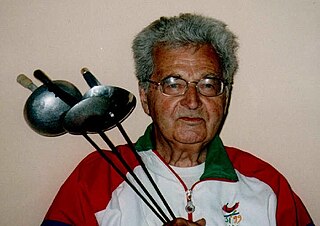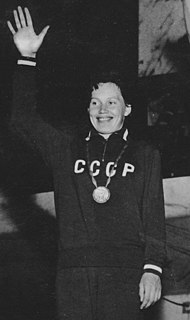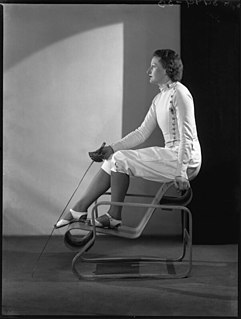Related Research Articles

Fencing is a group of three related combat sports. The three disciplines in modern fencing are the foil, the épée, and the sabre ; winning points are made through the weapon's contact with an opponent. A fourth discipline, singlestick, appeared in the 1904 Olympics but was dropped after that, and is not a part of modern fencing. Fencing was one of the first sports to be played in the Olympics. Based on the traditional skills of swordsmanship, the modern sport arose at the end of the 19th century, with the Italian school having modified the historical European martial art of classical fencing, and the French school later refining the Italian system. There are three forms of modern fencing, each of which uses a different kind of weapon and has different rules; thus the sport itself is divided into three competitive scenes: foil, épée, and sabre. Most competitive fencers choose to specialize in one weapon only.

A foil is one of the three weapons used in the sport of fencing, all of which are metal. It is flexible, rectangular in cross section, and weighs under a pound. As with the épée, points are only scored by contact with the tip, which, in electrically scored tournaments, is capped with a spring-loaded button to signal a touch. A foil fencer's uniform features the lamé. The foil is the most commonly used weapon in competition.

The épée, sometimes spelled epee in English, is the largest and heaviest of the three weapons used in the sport of fencing. The modern épée derives from the 19th-century épée de combat, a weapon which itself derives from the French small sword.

Aldo Nadi was one of the greatest Italian fencers of all time.

Michael Marx is an American foil and epee fencer and fencing master. He is the brother of Robert Marx, who has also represented the U.S. in multiple Olympic fencing events. Michael and his brother were taught to fence by their mother, fencing coach Colleen Olney, who is considered by many prominent fencers to be "the mother of fencing in Oregon".
The British Fencing Association (BFA), often referred to as British Fencing, is the national governing body (NGB) for the Olympic sport of Fencing in the British Isles.

Edoardo Mangiarotti was an Italian fencer. He won a total of 39 Olympic titles and World championships, more than any other fencer in the history of the sport. His Olympic medals include one individual gold, five team golds, five silver, and two bronze medals from 1936 to 1960.

Zbigniew Czajkowski was a Polish fencing coach. Czajkowski was dubbed "Father of the Polish School" of fencing. He coached many champions, including Egon Franke - the first Pole to earn an Olympic gold medal in fencing.

Allan Louis Neville Jay MBE is a British former five-time-Olympian foil and épée fencer, and world champion.
Byron Lester Krieger was an American foil, sabre and épée fencer. Krieger represented the United States in the Olympics in 1952 in Helsinki and 1956 in Melbourne, and in the 1951 Pan American Games where he won two gold medals.
The oldest surviving manual on western swordsmanship dates back to the 14th century, although historical references date fencing schools back to the 12th century.

Ferenc Marki was an internationally known fencing master and fencing coach.

Valentyna Ksenofontivna Rastvorova was a Soviet fencer who competed at the 1956, 1960 and 1964 Olympics in the individual and team foil events. She won a team gold and individual silver medals in 1960, and team silver medal in 1964. She also won six gold and two silver medals at the world championships of 1956–1967, mostly in the team foil.
Jon Willis is an épée fencer. In 2007, Jon became the first British fencer to win a World Cup since 1981.
Henry William Furse "Bill" Hoskyns MBE was a British fencer who appeared at six Olympic Games.,
John Erle Fethers was an Australian fencer. He competed in six events at the 1952 Summer Olympics. He was a longstanding member and coach at the Melbourne-based VRI Fencing Club. On 10 October 2009 in recognition of a significant international fencing career, outstanding personal contribution to Australian fencing, and lasting legacy in the training and development of numerous coaches and Olympic athletes, he was inducted as a Living Legend to the VRI Hall of Fame.
Peter Jacobs is a British fencer who competed at the Olympics.

Gwendoline Neligan was a London born, British/English foil fencer, and winner of the 1933 World Fencing Championships.
Marcello Lodetti graduated in 1959 from the Accademia Nazionale Magistrale (ANS) and started fencing at the age of 7 at the Mangiarotti fencing club in Milano, near the Giuseppe Verdi conservatory. He then became a pupil of Giuseppe Mangiarotti, who had himself been a pupil of Renaud.
References
- ↑ History of the BAF on the official website.
- ↑ "Academy News Archive". British Academy of Fencing. Retrieved 5 June 2021.